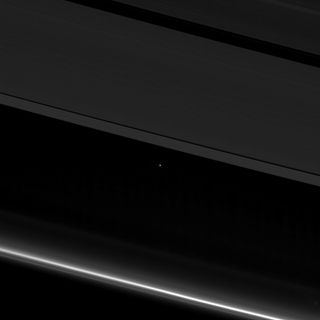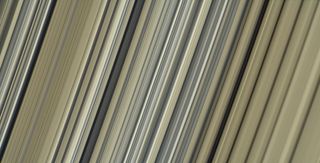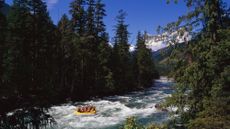Why the Cassini spacecraft is NASA's greatest achievement
Its mission has ended, but its legacy will live on


Today, NASA's venerable Cassini craft will fall into the clouds of Saturn, sending back scientific data even as it descends to its own demise. Then, it will go quiet, and the craft's incredible 20-year odyssey will come to an epic end. Cassini's mission has set an incredible benchmark to which future NASA missions can aspire, but its accomplishments will be hard to top. Arguably, no NASA mission has revealed so many worlds in such exquisite detail, or opened our minds to so many tantalizing possibilities.
Launched in October 1997, the craft finally arrived at the Saturn system in 2004 and got to work. It dropped a probe into an alien moon for the first time, discovering lakes of ethane on Titan hiding beneath the thick, smoggy clouds of the planet-sized moon, the second largest moon in the solar system.

Titan is believed to be one of the most promising places in the solar system for finding life, and Cassini confirmed that it bears more than a passing resemblance to a colder version of early Earth. In addition to being the only body aside from our home planet to have liquid on its surface (in the form of several hydrocarbons), Cassini revealed that Titan may have a second ocean hiding beneath its surface. This means life on Titan could originate in two completely separate places, resulting in very different kinds of lifeforms.
Subscribe to The Week
Escape your echo chamber. Get the facts behind the news, plus analysis from multiple perspectives.

Sign up for The Week's Free Newsletters
From our morning news briefing to a weekly Good News Newsletter, get the best of The Week delivered directly to your inbox.
From our morning news briefing to a weekly Good News Newsletter, get the best of The Week delivered directly to your inbox.
Then there's Enceladus. This seemingly unremarkable moon was hiding a secret, revealed by Cassini. While the Voyager missions suggested it was just a ball of ice, Cassini found incredible geysers spewing salty water hundreds of miles into space. As scientists looked closer, they discovered that the moon had a vast subterranean ocean in a world just 1/7th the size of our own moon. And where there's water on Earth, there's life, which means Enceladus may have the right ingredients to have ocean creatures of its own.

And those are just two of the 62 moons in the Saturn system, eight of which were newly discovered by the Cassini craft. Jupiter may have the biggest moons — Ganymede is larger than Titan, Callisto is a hair smaller, and Europa and Io are roughly the size of our moon — but Saturn has an entire fascinating system boasting seven moons of substantial size. Four of them — Iapetus, Rhea, Dione, and Tethys — are bigger than several known dwarf planets. Cassini was able to draw out details from these moons that the Voyagers couldn't. For example, it discovered that Iapetus, a world half-shrouded in a material so dark it doesn't reflect light, may get that dark gunk from another passing moon named Phoebe.
Cassini also gave us exquisite pictures of the "death star" moon Mimas, and pinpointed an intriguing problem: Mimas' gravitational pull didn't quite work for a solid body. At first Cassini scientists thought this might be due to an unseen ocean, but instead discovered something even stranger: Mimas had a football-shaped core. This could provide insight into how celestial objects round — a key part of what differentiates a dwarf planet from just another chunk of rock in space. (No offense, Pallas.)
There's also Tethys, which Cassini discovered had bright red streaks as if a child had dragged a marker over the moon's surface. There's Dione, which may have an ocean of its own. There's Rhea, which seems to be one giant snowball without a rocky core. And there are the smaller moons resembling items on a dinner plate, whether it's the ravioli shaped Pan or the microwaved-too-long baked potato that is Hyperion.
Sign up for Today's Best Articles in your inbox
A free daily email with the biggest news stories of the day – and the best features from TheWeek.com

None of these insights would have been possible without Cassini, which revealed more to us than the Galileo mission at Jupiter the previous decade. Due to a problem on Earth (they forgot to relubricate the expandable high gain boom after the craft was shelved for a few years), the Galileo team had to make due with what data the aging craft could send back. But Cassini went off relatively without a hitch, and even beamed back a few "pale blue dot" pictures of a tiny Earth nestled between the massive rings of Saturn.

The Voyager crafts are known as our interstellar messengers. Their mission was to visit the four outer planets before sailing out to interstellar space, where they continue to send back data at the very margins of the solar system. Those crafts launched 40 years ago this year.
But 20 years ago, we launched Cassini to finish what the Voyagers started. In return, we got hundreds of gorgeous pictures, valuable in-depth findings about our galactic neighbors, and perhaps the most promising candidate for life in our solar system. We even got to skim the majestic megastructure of Saturn's rings for the first time.

And now, with Cassini out of fuel, it's time to say goodbye. But not before our lonely messenger gives us one last unprecedented glimpse of the upper cloud layers of Saturn. And even after it has beamed its last broadcast, Cassini will leave us with nearly 400,000 images to comb through, and countless hours of scientific data waiting to reveal even more secrets of our solar system. Now, it's up to NASA to step up to the challenge and set the benchmark even higher.
Goodnight, so long, and thanks for filling us with wonder, Cassini.
Create an account with the same email registered to your subscription to unlock access.
John Wenz is a freelance writer based in Madison, Wisconsin. His works have appeared in Popular Mechanics, Discover Magazine, Astronomy Magazine, and more.
-
 Labour's Brexit conundrum
Labour's Brexit conundrumThe Explainer Keir Starmer backs 'twin track' strategy – build closer security ties with EU while ruling out single market, customs union and free movement
By The Week UK Published
-
 6 scenic white water rafting destinations to get your heart racing
6 scenic white water rafting destinations to get your heart racingThe Week Recommends Have a rip-roaring time on the water
By Catherine Garcia, The Week US Published
-
 Dangerous substances in Lunchables are raising concerns over children's health
Dangerous substances in Lunchables are raising concerns over children's healthIn the Spotlight High levels of lead and sodium were recently found in the snack packages
By Justin Klawans, The Week US Published